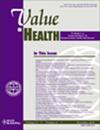Do We Always Need a New Preference Study? A Scoping Review of Promising Research Areas for Meta-Analyses and Benefit Transfers of Patient Preference Studies
IF 6
2区 医学
Q1 ECONOMICS
引用次数: 0
Abstract
Objectives
Although patient preference (PP) studies are costly, time intensive, and burdensome on patients, their findings are rarely used beyond the purpose of the original study. If PP study findings could be transferred to other contexts through meta-regression (benefit transfers), resources could be better utilized. We conducted a scoping review to assess the readiness of the current PP study landscape for evidence synthesis and benefit transfers.
Methods
Quantitative PP studies examining risks and benefits of treatments were identified through a systematic search on PubMed, Scopus, and Web of Science. Based on benefit transfer guidelines from environmental economics, prospects for transferring PP study findings were judged based on the number of studies across indications, consistency in elicitation methods, consistency in treatment attributes, and consistency in computed preference parameters.
Results
In total, 777 studies were included. Of these, 580 were discrete choice experiments (DCEs). Geographically, most studies were conducted in the United States (N = 271), multicountry designs (N = 105), Germany (N = 61), the United Kingdom (N = 59), and The Netherlands (N = 54). Indication wise, most research was concentrated in type 2 diabetes (T2D) (46 DCEs, 7 non-DCEs), psoriasis (24 DCEs, 8 non-DCEs), and multiple sclerosis (21 DCEs, 7 non-DCEs).
Conclusions
The landscape of PP studies is dispersed across various indications and therapeutic focus areas, which generally limits interstudy comparisons. However, numerous DCEs on T2D exhibited a high consistency in computed preference parameters and a moderately high degree of overlap in studied attributes (hypoglycemia, glycemic control, weight change, and out-of-pocket costs). Hence, benefit transfers seem feasible in T2D.
我们是否总是需要新的偏好研究?荟萃分析和患者偏好研究的利益转移的前景研究领域的范围综述。
目的:尽管患者偏好(PP)研究成本高、耗时长、给患者带来负担,但其研究结果很少用于原始研究目的之外。如果PP研究结果可以通过meta回归(利益转移)转移到其他情境中,资源就可以得到更好的利用。我们进行了范围审查,以评估当前PP研究格局对证据综合和利益转移的准备程度。方法:通过在PubMed, Scopus和Web of Science上进行系统搜索,确定定量PP研究检查治疗的风险和益处。根据环境经济学的利益转移指南,根据跨适应症的研究数量、诱导方法的一致性、治疗属性的一致性和计算偏好参数的一致性来判断PP研究结果转移的前景。结果:共纳入777项研究。其中580个是离散选择实验(dce)。从地理上看,大多数研究在美国(N = 271)、多国设计(N = 105)、德国(N = 61)、英国(N = 59)和荷兰(N = 54)进行。适应症方面,大多数研究集中在2型糖尿病(T2D)(46例dce, 7例非dce)、牛皮癣(24例dce, 8例非dce)和多发性硬化症(21例dce, 7例非dce)。结论:PP研究的前景分散在不同的适应症和治疗重点领域,这通常限制了研究间的比较。然而,许多关于T2D的dce在计算的偏好参数上表现出高度一致性,在研究属性(低血糖、血糖控制、体重变化和自付费用)上表现出中度高度重叠。因此,在T2D中,利益转移似乎是可行的。
本文章由计算机程序翻译,如有差异,请以英文原文为准。
求助全文
约1分钟内获得全文
求助全文
来源期刊

Value in Health
医学-卫生保健
CiteScore
6.90
自引率
6.70%
发文量
3064
审稿时长
3-8 weeks
期刊介绍:
Value in Health contains original research articles for pharmacoeconomics, health economics, and outcomes research (clinical, economic, and patient-reported outcomes/preference-based research), as well as conceptual and health policy articles that provide valuable information for health care decision-makers as well as the research community. As the official journal of ISPOR, Value in Health provides a forum for researchers, as well as health care decision-makers to translate outcomes research into health care decisions.
 求助内容:
求助内容: 应助结果提醒方式:
应助结果提醒方式:


